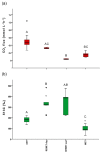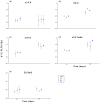Water level changes affect carbon turnover and microbial community composition in lake sediments
- PMID: 26902802
- PMCID: PMC4821186
- DOI: 10.1093/femsec/fiw035
Water level changes affect carbon turnover and microbial community composition in lake sediments
Abstract
Due to climate change, many lakes in Europe will be subject to higher variability of hydrological characteristics in their littoral zones. These different hydrological regimes might affect the use of allochthonous and autochthonous carbon sources. We used sandy sediment microcosms to examine the effects of different hydrological regimes (wet, desiccating, and wet-desiccation cycles) on carbon turnover. (13)C-labelled particulate organic carbon was used to trace and estimate carbon uptake into bacterial biomass (via phospholipid fatty acids) and respiration. Microbial community changes were monitored by combining DNA- and RNA-based real-time PCR quantification and terminal restriction fragment length polymorphism (T-RFLP) analysis of 16S rRNA. The shifting hydrological regimes in the sediment primarily caused two linked microbial effects: changes in the use of available organic carbon and community composition changes. Drying sediments yielded the highest CO2 emission rates, whereas hydrological shifts increased the uptake of allochthonous organic carbon for respiration. T-RFLP patterns demonstrated that only the most extreme hydrological changes induced a significant shift in the active and total bacterial communities. As current scenarios of climate change predict an increase of drought events, frequent variations of the hydrological regimes of many lake littoral zones in central Europe are anticipated. Based on the results of our study, this phenomenon may increase the intensity and amplitude in rates of allochthonous organic carbon uptake and CO2 emissions.
Keywords: carbon dioxide emission; keeling plot; phospholipid fatty acids; stable isotope; water level changes.
© FEMS 2016.
Figures





Similar articles
-
Response of the methanogenic microbial communities in Amazonian oxbow lake sediments to desiccation stress.Environ Microbiol. 2014 Jun;16(6):1682-94. doi: 10.1111/1462-2920.12267. Epub 2013 Oct 9. Environ Microbiol. 2014. PMID: 24118927
-
Structure and function of methanogenic microbial communities in sediments of Amazonian lakes with different water types.Environ Microbiol. 2016 Dec;18(12):5082-5100. doi: 10.1111/1462-2920.13491. Epub 2016 Aug 25. Environ Microbiol. 2016. PMID: 27507000
-
Microbial diversity in sediments of saline Qinghai Lake, China: linking geochemical controls to microbial ecology.Microb Ecol. 2006 Jan;51(1):65-82. doi: 10.1007/s00248-005-0228-6. Epub 2006 Jan 13. Microb Ecol. 2006. PMID: 16400537
-
Characterization of wheat straw-degrading anaerobic alkali-tolerant mixed cultures from soda lake sediments by molecular and cultivation techniques.Microb Biotechnol. 2015 Sep;8(5):801-14. doi: 10.1111/1751-7915.12272. Epub 2015 Mar 4. Microb Biotechnol. 2015. PMID: 25737100 Free PMC article.
-
Roles of Thermokarst Lakes in a Warming World.Trends Microbiol. 2020 Sep;28(9):769-779. doi: 10.1016/j.tim.2020.04.002. Epub 2020 Apr 30. Trends Microbiol. 2020. PMID: 32362540 Review.
Cited by
-
Effects of dry-wet cycles on nitrous oxide emissions in freshwater sediments: a synthesis.PeerJ. 2021 Feb 12;9:e10767. doi: 10.7717/peerj.10767. eCollection 2021. PeerJ. 2021. PMID: 33614277 Free PMC article.
-
Bacterial and Fungal Community Composition and Functional Activity Associated with Lake Wetland Water Level Gradients.Sci Rep. 2018 Jan 15;8(1):760. doi: 10.1038/s41598-018-19153-z. Sci Rep. 2018. PMID: 29335587 Free PMC article.
-
Microbial metabolic activity in Amazon floodplain forest and agricultural soils.Front Microbiol. 2023 May 24;14:1144062. doi: 10.3389/fmicb.2023.1144062. eCollection 2023. Front Microbiol. 2023. PMID: 37293212 Free PMC article.
-
Environmental Control on Microbial Turnover of Leaf Carbon in Streams - Ecological Function of Phototrophic-Heterotrophic Interactions.Front Microbiol. 2018 Jun 4;9:1044. doi: 10.3389/fmicb.2018.01044. eCollection 2018. Front Microbiol. 2018. PMID: 29915564 Free PMC article.
-
Fungal-bacterial dynamics and their contribution to terrigenous carbon turnover in relation to organic matter quality.ISME J. 2017 Feb;11(2):415-425. doi: 10.1038/ismej.2016.131. Epub 2016 Dec 16. ISME J. 2017. PMID: 27983721 Free PMC article.
References
-
- Attermeyer K, Hornick T, Kayler ZE, et al. Enhanced bacterial decomposition with increasing addition of autochthonous to allochthonous carbon without any effect on bacterial community composition. Biogeosciences. 2014;11:1479–89.
-
- Aufdenkampe AK, Mayorga E, Raymond PA, et al. Riverine coupling of biogeochemical cycles between land, oceans, and atmosphere. Front Ecol Environ. 2011;9:53–60.
-
- Becker R, Bubner B, Remus R, et al. Impact of multi-resistant transgenic Bt maize on straw decomposition and the involved microbial communities. Appl Soil Ecol. 2014;73:9–18.
-
- Billings WD, Luken JO, Mortensen DA, et al. Arctic Tundra – a source or sink for atmospheric carbon-dioxide in a changing environment. Oecologia. 1982;53:7–11. - PubMed
MeSH terms
Substances
LinkOut - more resources
Full Text Sources
Other Literature Sources
Molecular Biology Databases
Research Materials

